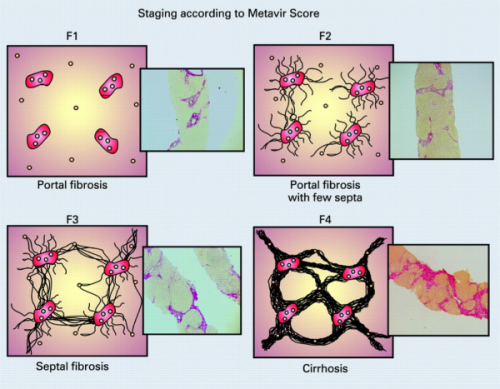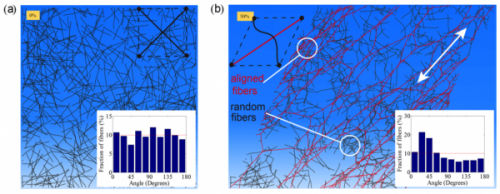Researchers model the mechanics of cells' long-range communication

Interdisciplinary research at the University of Pennsylvania is showing how cells interact over long distances within fibrous tissue, like that associated with many diseases of the liver, lungs and other organs.
By developing mathematical models of how the collagen matrix that connects cells in tissue stiffens, the researchers are providing insights into the pathology of fibrosis, cirrhosis of the liver and certain cancers.
Tissue stiffness has long been know to be clinically relevant in these diseases, but the underlying changes that alter the mechanics of tissues are poorly understood. Consisting of a complex network of fibers, tissues have proven difficult to simulate and model beyond local, neighbor-to-neighbor interactions.
Developing a better understanding of the large-scale mechanical changes that occur over longer distances, specifically the process by which the extracellular matrix is pulled into compact, highly-aligned "bridges," could eventually form the basis of treatments for related diseases.
Vivek Shenoy, professor in the Department of Materials Science and Engineering in Penn's School of Engineering and Applied Science, has led an interdisciplinary research team to tackle this problem, authoring a pair of papers that were published in Biophysical Journal.
One, "Remodeling of Fibrous Extracellular Matrices by Contractile Cells: Predictions from Discrete Fiber Network Simulations" involved developing simulations that extrapolated the overall remodeling of the extracellular matrix based on the behavior of neighboring pairs of cells. The other, "Long Range Force Transmission in Fibrous Matrices Enabled by Tension-Driven Alignment of Fibers," took a more mathematical approach, producing a coarse-grained model of this remodeling that could be more broadly applied to fibrotic tissue.
"We're trying to understand how force is transmitted in tissues," Shenoy said. "Cells are the ones that generate force, and it has to be transmitted through what surrounds the cell, the extracellular matrix, or ECM. But imagine trying to model the ECM by trying to keep track of each collagen fibril in your liver; there are tens of millions of those. So we're taking what we learn from simulating those networks to turn it into a model that captures the main features with only a few parameters.

"The key here is the mechanics," he said. "In particular, how does ECM, as a fibrous material, differ from solids, gels and other materials that are better studied."
Rebecca Wells, an associate professor in Penn's Perelman School of Medicine and a co-author on the latter paper, provided insight into the clinical relevance of the mechanics that characterize ECM-related disorders.
"Fibrosis occurs when you have an injury and the tissue responds by depositing ECM, forming scar tissue," Wells said. "In liver fibrosis, the liver can stiffen by up to an order of magnitude, so measuring stiffness is a common diagnostic test for the disease. Increased stiffness also occurs in cancer, where tumors are typically stiffer than the surrounding tissue."
Existing experimental evidence showed that mechanical forces were at play in the changes in both fibrosis and cancer and that these forces were important to their development and progression but could not explain the long-ranging changes cells were able to produce to change their environments. When put in tissue-simulating gels, cells can deform their immediate surroundings but are unable to pull on more distant cells. In real, ECM-linked tissue, however, cells' range of influence can be up to 20 times their own diameter.
Discover the latest in science, tech, and space with over 100,000 subscribers who rely on Phys.org for daily insights. Sign up for our free newsletter and get updates on breakthroughs, innovations, and research that matter—daily or weekly.
"If you look at a normal tissue," Shenoy said, "you see the cells are more rounded, and the network of ECM fibers is more random. But as cancer progresses, you see more elliptical cells, more ECM, and you see that the ECM fibers are more aligned. The cells are the ones generating force, so they're contracting and pulling the fibers, stretching them out into bridges."
"That's also the pathology of cirrhosis," Wells said. "My group had been looking at the early mechanical changes associated with liver fibrosis, which progresses to cirrhosis, but then, by collaborating with Vivek, we started to wonder if these large scale changes in the architecture of the liver could have a mechanical basis and if something similar to what is seen in gels might be occurring in the liver. This is a new way of approaching the problem, which has largely been thought of as biochemical in origin. And there are other tissues where it is probably the same thing, the lung, for example."
The researchers found that the critical difference between the existing models and ECM's long-range behavior was rooted in its elastic properties. Materials with linear elasticity cannot transmit force over the distances observed, but the team's simulations showed that nonlinear elasticity could arise from the ECM's fibrous structure.
"In our model, every component is linearly elastic," Shenoy said, "but the collective behavior is nonlinear; it emerges because of the connectivity. When you deform the network, it's easy to bend the 'sticks' that represent collagen fibers but hard to stretch them. When you deform it to a small extent, it's all the bending of the fibers, but, as you deform further, it can't accommodate bending any more and moves over to stretching, forming the bridges we see in the tissue."
Such simulations can't predict which fibers will end up in which bridge, necessitating the coarser-grained model the researchers described in their second paper. By showing the point at which linear elasticity gives way to its nonlinear counterpart, the team produced a more complete picture of how the alignment of collagen bridges under tension transmit force between distant cells.
Further studies are needed to elucidate the feedback loops between ECM stiffening and cell contraction strength. The team is conducting physical experiments to confirm and refine their in silico findings.
"Right now," Wells said," we're hypothesizing that the mechanical interactions modeled by the Shenoy lab explain aspects of cancer and fibrosis, and we're developing the experimental systems to confirm it with real cells."
More information: "Remodeling of Fibrous Extracellular Matrices by Contractile Cells: Predictions from Discrete Fiber Network Simulations" DOI: dx.doi.org/10.1016/j.bpj.2014.08.029
"Long-Range Force Transmission in Fibrous Matrices Enabled by Tension-Driven Alignment of Fibers" DOI: dx.doi.org/10.1016/j.bpj.2014.09.044
Journal information: Biophysical Journal
Provided by University of Pennsylvania



















